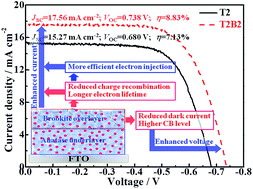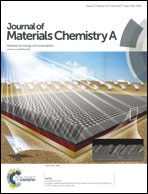Preparation of brookite titania quasi nanocubes and their application in dye-sensitized solar cells
Abstract
Brookite TiO2 quasi nanocubes with high phase purity and thermal stability were synthesized through a hydrothermal process. The obtained brookite TiO2 quasi nanocubes have a mean size of ∼50 nm with a specific surface area of ∼34.2 m2 g−1. When used as a photoanode material, the single brookite TiO2 nanocubes film-based dye-sensitized solar cell (DSSCs) shows higher open-circuit voltage but lower conversion efficiency than the single nanosized anatase TiO2 film-based one with a similar film thickness; while using the brookite TiO2 nanocubes as an overlayer of the nanosized anatase TiO2 film, the fabricated bilayer solar cells exhibit significant enhancement in both the open-circuit voltage and short-circuit current. In addition, the corresponding bilayer solar cell with an optimized overlayer thickness gives a conversion efficiency up to 8.83% with a 23.8% improvement when compared to the single anatase cell (7.13%). The brookite nanocubes used as an overlayer not only reduce the charge recombination and dark current, but also prolong the electron lifetime, which leads to an enhanced voltage and photocurrent, and therefore the improved photovoltaic performance of the bilayer solar cell. These results demonstrate the simple fabrication method used to prepare brookite TiO2 nanocubes and their application as an overlayer are promising and offer a strategy for the development of low-cost and high efficiency DSSCs through tuning the photoanode's components and structure.


 Please wait while we load your content...
Please wait while we load your content...